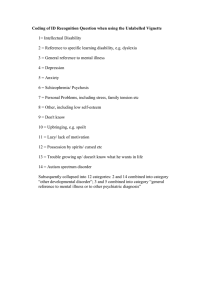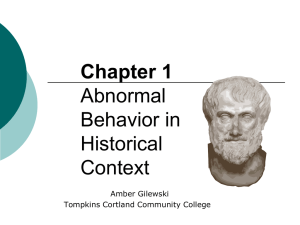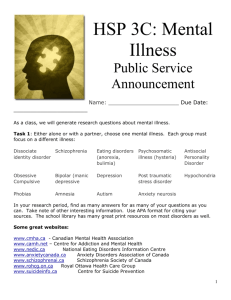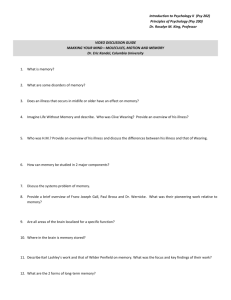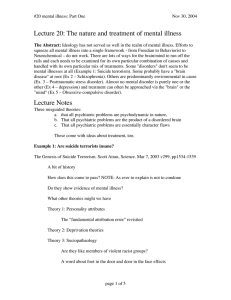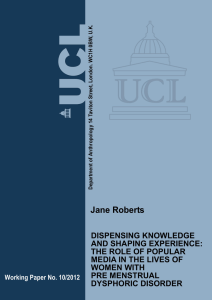Day 2: Chapter 1
advertisement
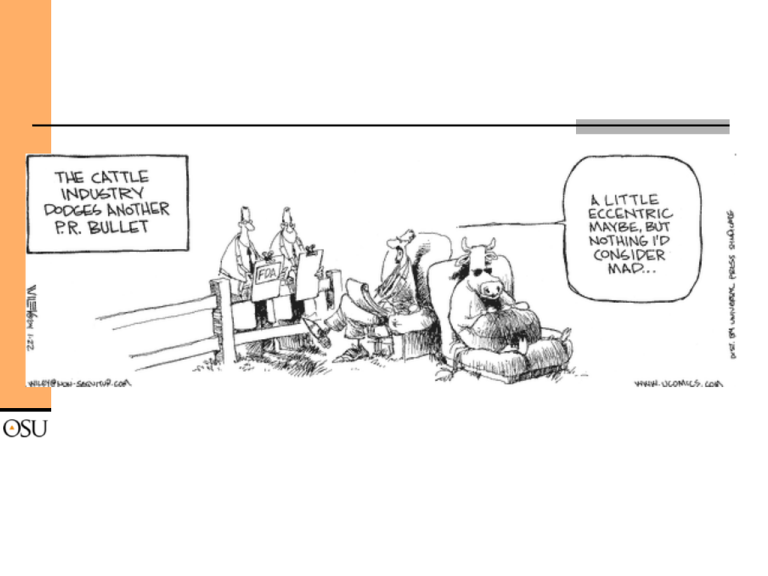
Historical Context of Abnormal Psychology and Definitions of Abnormal Behavior Chapter 1 Some Terms & Definitions Psychopathology Prevalence - # people with the disorder at a given time Incidence - # new cases in a given time period (# people who develop the disorder) Prognosis – the expected course and outcome of the disorder Etiology – causes of the disorder, how & why it developed The Past: Abnormal Behavior and the Supernatural Tradition Deviant behavior as a battle of “Good” vs. “Evil” Deviant behavior was believed to be caused by demonic possession, witchcraft, sorcery Mass hysteria and the church Treatments included exorcism, snake pits, beatings, and crude surgeries Movement of the moon and stars as a cause of deviant behavior Paracelsus and lunacy Both “Outer Force” views were popular during the Middle Ages Few believed that abnormality was an illness on par with physical disease trephination The Past: The Biological Tradition Comes of Age Hippocrates & Galen- 4 humors (blood, black bile,yellow bile, phlegm), melancholic, phlegmatic, choleric, hysteric personalities General paresis (Syphilis) and the biological link with madness Associated with several unusual psychological and behavioral symptoms Pasteur discovered the cause – A bacterial microorganism Led to penicillin as a successful treatment Bolstered the view that mental illness = physical illness and should be treated as such John Grey, MD., Psychiatrist, American Journal of Insanity. “All mental illness due to physical causes”. The Past: Consequences of the Biological Tradition Mental Illness = Physical Illness The 1930s: Biological treatments were standard practice Insulin shock therapy, ECT, and brain surgery (i.e., lobotomy) By the 1950s several medications were established Examples include neuroleptics (i.e., reserpine) and major tranquilizers Psychological Traditions Moral Therapy & Mental Hygiene Movement (1700s – Late 1800s) Pinel, Tuke, Rush, and Dorothea Dix Psychoanalytic Theory (late 1800s – 1950s) Mesmer, Charcot, Freud, psychodynamic theory, psychoanalysis Humanistic Theory (post-WWII) Rogers, Maslow, self-actualization Behavioral Model (1920s – 1970s) Watson, Pavlov, Skinner, behavior therapy Cognitive-behavioral Model (1960s – present) Bandura, Beck, cognitive-behavioral therapy
